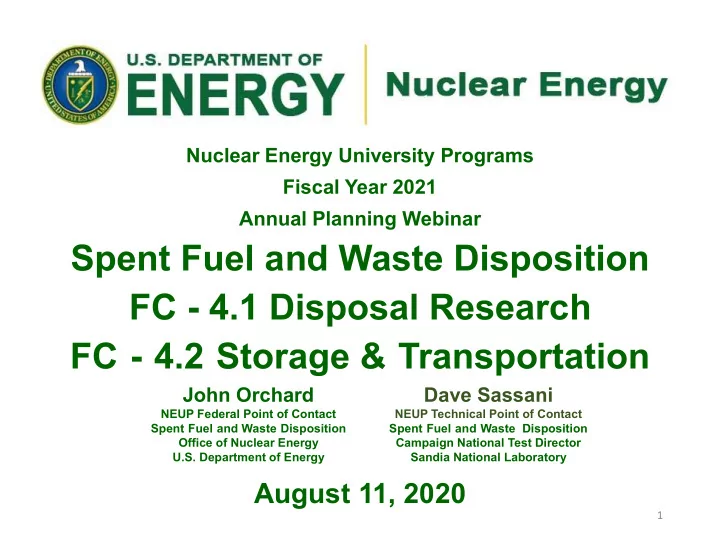

Nuclear Energy University Programs Fiscal Year 2021 Annual Planning Webinar Spent Fuel and Waste Disposition FC - 4.1 Disposal Research FC---4.2-Storage &-Transportation John Orchard Dave Sassani NEUP Federal Point of Contact NEUP Technical Point of Contact Spent-Fuel-and Waste-Disposition Spent-Fuel-and-Waste–Disposition Office of Nuclear Energy Campaign National Test Director U.S. Department of Energy Sandia National Laboratory August 11, 2020 1
Spent Fuel Disposition Overview DOE Office of Nuclear Energy Mission Advance nuclear power as a resource capable of meeting the nation's energy, environmental, and national security needs by resolving technical, cost, safety, proliferation resistance, and security barriers through research, development, and demonstration as appropriate Spent Fuel and Waste Disposition Mission Identify alternatives and conduct scientific research and technology development to enable storage, transportation and disposal of spent nuclear fuel and wastes generated by existing and future nuclear fuel cycles 2
Spent Fuel Disposition Campaign R&D Participants 3
Spent Fuel Disposition Grand Challenge The Grand Challenge for the Spent Fuel and Waste Campaign is to provide a sound technical basis for the safety and security of long-term storage, transportation, and disposal of spent nuclear fuel and wastes from the nuclear energy enterprise Importance: Supports the establishment of SNF management and disposition pathways 4
Spent Fuel Disposition Research Needs Disposal Provide a sound technical basis for assurance that the US has multiple viable disposal options available when national policy is ready Identify and research generic sources of uncertainty that challenge the viability of disposal concepts Increase confidence in robustness of generic disposal concepts to reduce the impact of site-specific complexity Develop the science and engineering tools required to address the needs above Storage & Transportation Develop the technical bases: To demonstrate used fuel integrity for extended storage periods For fuel retrievability and transportation after extended storage For transportation of high burnup fuel 5
NEUP R&D Work Scope Description: Spent Fuel Disposition FC-4.1: Disposal Generic Geologies • clay/shale • salt • crystalline rock • tuff Barriers for Waste Isolation Natural Barriers: • Saturated or Unsaturated • Reducing or Oxidizing Engineered Barriers: • Backfill • Container, Overpack, etc. • Waste Form (glass, ceramic) 6
FC-4.2 Storage & Transportation Storage System Components I. Fuel Fuel/Pellet Cladding Assembly hardware III. ISFSI Pad II. Cask Rebar Physical Protection Internals (baskets, neutron poisons) IV. Monitoring Systems Container (canister, welds, seals, bolts) Remote inspection Overpack/Storage In-package sensors module Security 7
Spent Fuel Disposition FC-4 Focus Areas for University Research Proposals Program Supporting R&D proposals are being solicited in the Spent Fuel Disposition Areas: FC-4.1 Disposal, and FC-4.2 Storage & Transportation (University-led up to $800,000 for 3 years) 8
Spent Fuel Disposition FC-4.1 Disposal Develop new and improved concepts, data, and models to demonstrate total system performance of the permanent disposal of spent nuclear fuel and high-level radioactive waste. This should apply to a variety of generic deep geologic repository concepts in clay/shale, salt, crystalline rock, and tuff. The research should include one of the following strategies: Barrier material development and experimenting/testing/investigating/characterizing methods advancement Data quality improvement and model enhancement focusing on sensitivity analysis, uncertainty quantification, reducing uncertainties The research should address one or more of the following interest areas: Improved understanding of waste package failure modes Improved data and understanding of aqueous speciation and geochemistry of radionuclides Improved understanding and new concepts for engineered and natural barrier systems New concepts or approaches for alleviating post-closure criticality concerns 9
Spent Fuel Disposition FC-4.2 Storage & Transportation Develop novel technologies for monitoring Spent Nuclear Fuel (SNF) in Dry Storage Canisters (DSC) for the following internal conditions: Canister leakage: o Helium and/or helium – air mixture o Internal pressure o Internal temperature Corrosion conditions and/or products: o Free and/or vapor water o Hydrogen Fuel/cladding degradation: o Xe and/or Kr gas o Dose Equipment specifications: o No penetrations through the DSC wall o All sensors and equipment can be external to the DSC o Sensors can be inside, send signals through wall to equipment outside the DSC o Internal sensors must be radiation hardened, very small and unobtrusive, compatible with internal components, and self-powered or remotely powered 10
Questions? Prasad Nair: FC-4.1 prasad.nair@nuclear.energy.gov John Orchard: FC-4.2 john.orchard@nuclear.energy.gov Dave Sassani: SNL dave.sassani@snl.gov 11
Recommend
More recommend